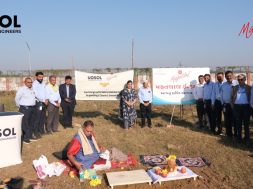
In Short : Maharashtra Deputy CM Devendra Fadnavis has set a September 2025 deadline to solarize 5,000 MW of agricultural feeders under the Mukhyamantri Saur Krushi Vahini Yojana 2.0. The initiative aims to provide daytime power to farmers while reducing the state’s electricity subsidy burden. So far, around 1,000 MW has been achieved, with efforts underway to accelerate implementation.
In Detail : Maharashtra Deputy Chief Minister Devendra Fadnavis has set a firm deadline of September 2025 to complete the solarization of 5,000 MW of agricultural feeders under the Mukhyamantri Saur Krushi Vahini Yojana 2.0. The initiative is part of the state’s broader effort to ensure reliable daytime power supply to farmers while curbing the financial strain of electricity subsidies.
Fadnavis reviewed the progress of the scheme during a high-level meeting with senior officials from the energy department and distribution companies. He emphasized the need to expedite work on existing and upcoming projects to meet the targeted capacity on time.
Currently, Maharashtra has achieved solarization of about 1,000 MW under the scheme. While this is a significant milestone, the state needs to accelerate its efforts in the coming months to meet the remaining 4,000 MW target within the stipulated timeline.
The Mukhyamantri Saur Krushi Vahini Yojana aims to supply power to agricultural feeders during daylight hours through decentralized solar projects. This approach reduces transmission losses and enables cost savings by limiting reliance on thermal power and conventional sources.
Under the revamped scheme (version 2.0), solar projects are being installed closer to agricultural zones, ensuring local power generation and distribution. The plan encourages private participation and offers incentives to developers for rapid deployment of solar assets.
Fadnavis highlighted that providing daytime electricity through solar power would improve farm productivity and reduce farmer dependency on erratic power supply schedules. It would also lead to significant long-term savings for the state by lowering recurring subsidy payouts.
The deputy CM directed officials to prioritize land acquisition and grid connectivity issues that often delay solar feeder projects. He called for inter-departmental coordination to address bottlenecks and ensure smooth implementation across all districts.
Officials were also instructed to explore innovative financing models and public-private partnerships to scale up project execution. A real-time monitoring system is being developed to track progress and identify gaps in execution.
This solar push forms a critical component of Maharashtra’s energy transition roadmap. If achieved on schedule, it will not only empower farmers but also set an example for other states aiming to blend agricultural development with renewable energy goals.











